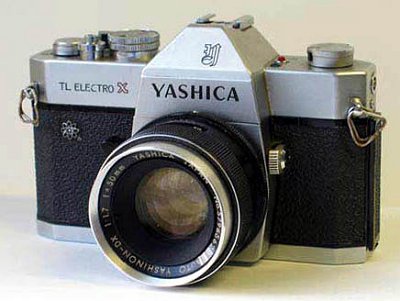How the Older Photos were Taken
I simply do not recall the exact Yashica model camera I had back in the late 1970s, but the one to the left is pretty close to it. I received it as a graduation gift, and when I headed off to Germany for my Army duty, this camera went along.
I took it EVERYWHERE, and it took one incredible beating. I dropped it onto the tank turret floor multiple times; dropped it in the mud a few times; smacked it against the armor of the turret a few times.... you get the picture.
As a consequence, while it still took pictures, significant problems began to crop up. The most difficult problem was that of light getting into the shutter box, thus causing irregular exposure of the film. I also somewhere along the line damaged the manual rewind mechanism. This was costly on one trip, as I broke one roll of film and lost over 20 photos along the Rhein River... photos that I retook by retracing my foot hike along the river.
This camera was completely manual... manual focus and manual light settings. This was a real challenge when taking photos from a moving tank... especially when bouncing about cross country. Nevertheless, with practice I got very good at it, and could focus, adjust light, and snap off a shot in a matter of seconds. I started by using ASA 100 film, but later switched to ASA 400. The latter has superior low light performance, but when one moves up the ASA spectrum, the imagery becomes grainy. Yet, ASA 400 gave me excellent photos, as can be attested by those on this site.
As for the lens, while detachable, the older Yashicas used the universal mounting system, rather than bayonet. It was very difficult to get additional lenses for this camera, and when I did find them, they were expensive. Therefore, all of my photos were taken with the basic lens. I did on a few occasions try a homemade zoom... focusing the camera through my binoculars! A few shots actually came out fair. Furthermore, I did not use any filters, as at this time I was too much of a photographic novice.
Finally, all older photos on this site come from a direct scan of the negatives. My older prints have yellowed over the years, and I have discarded most of them. However, scanning the negatives provided good results, though I had some trouble with debris on the film which I could never quite get rid of. The scans were done with the Epson 3490 Scanner. This runs about $100 dollars (2006) and is perfect for the basic work I did for this site. It also has excellent OCR recognition software, which includes numerous foreign language scanning ability. No... it doesn't translate the material, but it will recognize specialized characters in a language. If you need larger batch scanning and better quality, get ready to dish out a lot more money. But for basic work, I highly recommend this scanner.

